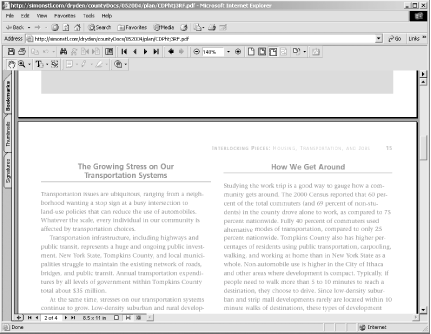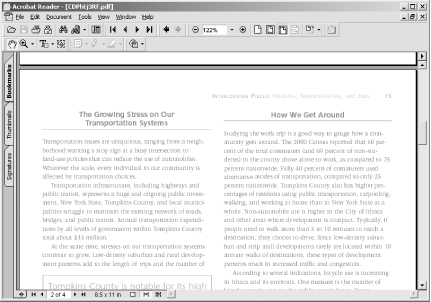Hack 1 Read PDFs with the Adobe Reader
![]()
![]()
Use Adobe's Acrobat Reader, renamed Adobe Reader in its latest release, to read PDF files on the Web and elsewhere.
Lots of web sites that use PDF files include a Get Adobe Reader icon along with the PDF files. Whether you're running Windows, Mac OS X, Mac OS 7.5.3 or later, Linux, Solaris, AIX, HP-UX, OS/2, Symbian OS, Palm OS, or a Pocket PC, Adobe has a reader for your platform. (Different platforms are frequently at different versions and have different capabilities, but they all can provide basic PDF-reading functionality.)
To get your free reader, visit http://www.adobe.com/products/acrobat/readstep2.html. You'll need to choose a language, platform, and connection speed, and then a second field showing your download options will appear. Each version has slightly different installation instructions, but when you're done you'll have either the Adobe Reader or Adobe Acrobat Reader installed. The installer will also integrate Reader with your web browser or browsers, if appropriate.
|
Once Reader is installed, clicking web site links to PDFs will bring
up a reader that enables you to view the PDFs, typically inside the
browser window itself. You can also open PDFs
on your local filesystem by
selecting File 
Figure 1-1. Viewing a PDF document through Acrobat Reader in the browser

Figure 1-2. Viewing a PDF document through Acrobat Reader running as a separate application

As with any GUI application, you can scroll around the document, and Acrobat provides zoom options (the magnifying glass and the zoom percentage box in the toolbar), print options (the printer), search options (the binoculars), and navigation options (the arrows in the toolbar, as well as the Show/Hide Navigation Pane button to the left of the arrows that enables you to see bookmarks, if any are provided by the document's creator). Unlike the commercial Acrobat applications, Reader doesn't provide means for creating or modifying PDF documents.
After installing Reader, adjust its program properties to
ensure you get the best reading experience. In Reader 5 or 6, access
these properties by selecting Edit 








